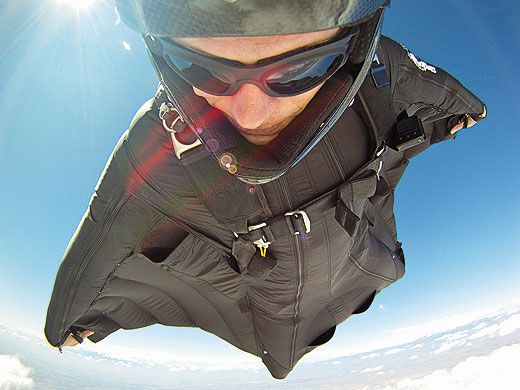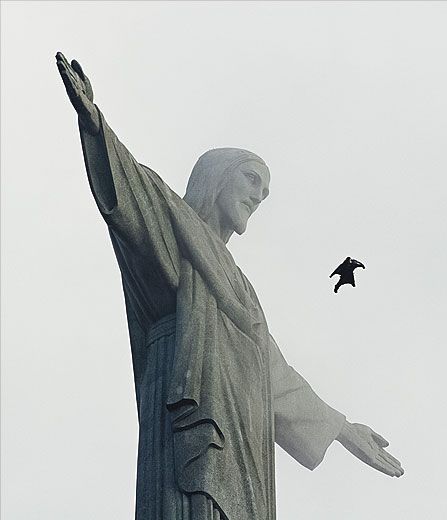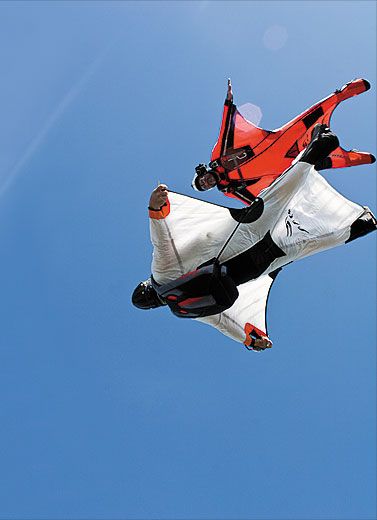Jump. Fly. Land.
Jeb Corliss says if the birds can do it, so can he
/https://tf-cmsv2-smithsonianmag-media.s3.amazonaws.com/filer/Jump_Fly_Land_FLASH_2.jpg)
The dream has recurred since childhood: I jump, and I can fly. I’m amazed. There are no awkward flapping wings, no roaring engines, no hang glider over my head. Just me flying, pure and delightful. I’m up and whizzing over the landscape, and it’s as simple as that.
“Flying in a wing suit is that dream!” says Jeb Corliss. “It’s the closest you can come to real human flight.” At home in Venice, California, Corliss is barefoot and dressed in black pajama-like pants and a black T-shirt. His head is shaved, and he’s tall and lanky—a bit stork-like. He grabs an iPad and flicks it with his long fingers and there’s a video of men—in weird stretchy suits that make them look like giant flying squirrels—streaking through the air five feet over sawtooth ridge tops and banking along stony cliffs, and all I can think is: It’s my dream come to life.
The modern wing suit was born in the 1990s, and ever since, wing suit fliers and designers (they are for the most part one and the same) have been nurturing that dream, extending the glide ratio of the free-falling skydiver or BASE jumper (an acronym for Buildings, Antennas, Spans and Earth’s natural features, like cliffs). They’ve pushed it to a bit more than three miles forward for each mile in lost altitude, abetted by high-tech fabrics and “wings” that channel in-rushing air to create lift.
Alas, a chute must always be deployed. But what if you could jump from the sky and fly through the air and land, just like a bird? Corliss sees that as the purest form of human flight. He wants to be the first person to jump out of an airplane and land safely without a parachute, and make it repeatable. The plan has a lot of ifs, and the biggest is money. He needs about $3 million to erect, in the middle of the Las Vegas strip, a ramp hundreds of feet tall. It would look like a ski jump, but act as a landing slope. Since Corliss would bellyflop on it head forward, arms back, he’s found it difficult to persuade people with deep pockets to finance what, after all, could become a televised suicide.
The notion of fatality aside, however, any discussion about landing without a parachute has to start with this fact: Ever since the invention of the airplane, a few people have fallen out of the sky without parachutes and lived to tell the tale. Nick Alkemade, a Royal Air Force tail gunner, jumped from his flaming turret in 1944 without a parachute and fell 18,000 feet into Germany. When he came to, he saw stars overhead and, with no more than a sprained leg, lit a cigarette. Alkemade’s luck? Fir trees, underbrush, and snow. Three decades later, a terrorist’s bomb blew up a DC-9 flown by Yugoslavia’s JAT airline, and Serbian flight attendant Vesna Vulovic fell 33,000 feet. She landed in snow and lived. There have been others. Roy Haggard, a longtime aerospace engineer and chief technologist at Hunter Defense Technologies in Solon, Ohio, says, “If it’s been done by accident with an incredibly low probability of success, well, it just becomes an engineering problem, and not a stunt, that in fact has a statistical probability of success.”
AT THE HEART of Corliss’ plan lie the challenges inherent in the human body’s design. While even large birds are light as a feather, with hollow bones and long, wide wings, humans are dense objects, with long, heavy legs and short, heavy arms—and no wings. Corliss recites a history starting in ancient times of wingnuts who jumped from buildings, often to their deaths. Today, the closest thing to pure flight remains a hang glider. It avoids the problem of our physiology with a set of big, relatively rigid wings. When the first modern wing suit flier, a French skydiver named Patrick de Gayardon, created a nylon jump suit in the mid-1990s with fabric between his legs and extending from his wrists to his waist, with open cells that gathered air, he suddenly had the first suit that served as an airfoil. De Gayardon managed only a 1:1.3 glide ratio, little better than a skilled skydiver in freefall. He died in a fall in 1998 when a new packing method he was trying for his rigging caused it to fail, and left unrealized his dreams for the potential of wing suits.
A year after de Gayardon’s death, a Croatian, Robert Pecnik, became the first person to manufacture and sell wing suits. Over the next decade, surface area increased. The wings of today’s suit extend from the wrists to the ankles. Short of adding appendages to the human body, designers cannot add surface area. This is where wing suit art and wing suit science collide. Using wind tunnels for research is difficult because the dummies would be static and rigid, whereas real wing suit flying involves humans flexing muscles and moving the hands, arms, legs, feet, and head. Also, the tunnel’s air stream flows in one direction, while a wing suit flier is dropping and moving forward. And a theoretical test body, a mannequin, has to be scaled to exactly 40 percent of the diameter of the tunnel to get the right air flow. The wing suit community is so small—maybe 600 worldwide, Pecnik estimates, with a mere 40 or 50 who “proxy,” or fly close to cliffs and buildings—that there’s just not enough money for the kind of research that might significantly increase glide distances.
All of which means that Jeb Corliss, flying the best suit money can buy (about $1,500), will be hurtling downward and forward hard and fast. He’s got lift, for sure, but he’ll be traveling at more than 100 mph, dropping a foot for every three feet forward. It’s the maximum glide angle, and one at which he can’t get more lift; he can’t suddenly flare up while screaming in toward a landing. “An airplane comes in at a certain approach speed and the pilot pulls the stick back and flares, and that neutralizes the sink rate,” says Mark Maughmer, a professor of aerospace engineering at Pennsylvania State University. “You’re trading the airspeed you have, its kinetic energy, into potential lift for a moment.” But Corliss will have precious little flare. Which is why wing suit fliers on proxy flights don’t, in fact, go for maximum glide angle, so they have a little something in reserve in case they need to swoop over and away from objects. Corliss, then, will travel even faster, and that’s the essence of the challenge: Come in for a landing so fast with so little lift that his abort options are extremely limited.
In person, Corliss doesn’t come across as crazy. Passionate, yes. Driven. Dedicated to sucking the most out of life, and resistant to the rules that keep most of us inside an airplane until it lands. He is deep-voiced and loud, a kinetic presence. No odd loner, he has a girlfriend and a mother who support his passion. He grew up all over the world and was home-schooled after the sixth grade by art-dealer parents. At an early age he grew fond of snakes and danger; even now his other passion besides BASE jumping and wing suit flying is hanging around wild predators. Skydiving bored him. “It’s pointless,” he says. In his early 20s he turned to BASE jumping, which “begins where skydiving ends.” Skydiving is a regulated sport: A parachute must be deployed by 2,000 feet, and divers must jump with two chutes. A BASE jumper’s fall is so short, often from heights starting below 2,000 feet, that there’s no time for an emergency chute; they carry just one. Corliss was BASE jumping in Italy in 1998 when he saw his first wing suit flight. “I watched a guy jump off and fly away and it looked like a long glide. It was instant: I thought, This has the potential to change the world of flying for humans without airplanes.” He called Pecnik and bought his first suit, flew it 10 times out of an airplane, and headed to South Africa. BASE jumping friends said they knew of “an amazing cliff” there that overlooked a series of descending ledges. Ordinarily, jumpers open a parachute, land on a second ledge too big to clear in flight, then jump again. “But if you had a wing suit,” Corliss says, “you could jump and then fly over the second ledge.”
A Russian friend of Corliss’ jumped and soared right over the second ledge. “He made it, and it was like seeing the impossible! I mean a year before, it couldn’t have been done, and at that moment I learned that the impossible doesn’t exist.” Then Corliss leapt, his first BASE jump with a wing suit. He soon realized he didn’t have enough lift to make it over the second ledge, and he was too low to open his parachute. Luckily, perpendicular to the ledges was “this giant crack that dropped downward.” He banked left and dove into that gorge and was suddenly proxy flying like a spacecraft in Star Wars, a man with no aircraft coursing through a crack in the Earth. “Dude, that flight was oh-my-God crazy and I was like instantly, wow!” No sooner had he popped his chute than he was analyzing his flight, which had tracked above a long slope, followed by a quick break to one side when he realized he needed to change his path. With that level of control, he thought: Man, I could land one of these things.
In 2003, he began to explore every conceivable option. He looked at nets, but unless he could land on his back, the possibility of breaking his neck seemed too high. He looked at plowing out a long runway on a snowy mountain slope. “I could set down with ease, but I’d be traveling at 100 miles an hour, and once down I’d have no control. Too much friction. Too high a probability of tumbling. Too many variables that I couldn’t control.” The problem remained a high approach speed with few options, and only a fraction of a second to decide whether to land. “You have to deploy a parachute at 200 feet in order to use it, but above 200 feet you’re too high to know if you’re lined up right. You don’t have the depth perception, and you’re traveling faster than your mind can make decisions, so you really don’t know until you’re five feet above the landing zone, but then it’s way too late for anything. A pilot’s basic training is go-arounds, but there aren’t any go-arounds in a wing suit landing. I was stumped.”
By then Corliss was a professional BASE jumper, earning money for everything from video footage of proxy flying to hosting a show on the Discovery Channel. In 2007, a TV crew in Brazil asked him to jump from a helicopter and fly by the hand of Rio de Janiero’s 130-foot-tall Christ the Redeemer statue, itself atop a 2,300-foot peak. He’d have to fly just beneath the arm and then clear the fence surrounding the statue’s base. He wasn’t sure he could do it for the same reason he fretted about a landing someday: Would he be traveling too fast to hit the requisite marks? “There are just too many decisions for a human to make in a hundredth of a second,” he says. In a series of practice flights he flew closer and closer to the arm until he had an epiphany: The statue gave him three-dimensional reference points during his rapid descent. By the third run he knew he could do it, and the next day he made eight flights, which he shows me on a video. In it, he’s a bullet screaming just under the arm and barely six feet over the fence. After that, he knew two things: “I knew how accurate I could be, that I could hit a six- by six-foot window easily,” he says. “And I had to build something like that statue that would show me where I was in space.”
Taking some of Roy Haggard’s advice, Corliss came up with a plan of attack, which he’s reluctant to describe in too much detail. He would build a landing ramp made of tightly stretched fabric attached to a 40- to 60-story building, beginning at a 45-degree angle—a 1:1 glide ratio. (Haggard thinks that’s too steep.) The building and ramp would provide that 3D reference to which he could line up as he hurtled downward. The angle would give him control options, because he could vary his rate of descent up to a 3:1 glide ratio. And because the approach end of the ramp would be between 400 and 600 feet high, he would have the time and altitude to act on any doubts, peel away, and pop his chute. He had his go-around. “Look,” Corliss says, pulling up a video of the world record ski jump. “He’s flying 239 meters with an air time of seven seconds, and this shows that you can be in free fall at a high speed and safely set down and do it over and over again.” Corliss selects another video of motorcycle racers crashing in protective suits—their bodies skidding and tumbling at high speed across pavement—and then walking away. “Once you set down, there’s a lot of friction and it can melt you in your suit, but these crashes show that with the right protective gear with a rigid neck brace in conjunction with a wing suit, well, you can deal with the friction.”
TO PAY FOR IT ALL, he needs sponsors, and that means crowds and television. “A cliff somewhere?” he asks. “There’s no money in that!” So he came up with Vegas, baby, home of the outlandish and the big gamble, and plenty of tall buildings. “We could have 500,000 spectators and suddenly that $3 million price tag doesn’t seem so big. I mean, imagine summiting Everest for the first time in front of a huge crowd!”
For Haggard, it’s plausible, but beyond his comfort level. “What Jeb is trying to do is conceptually possible with the proper engineering applied, and as long as he listens to the data. Safety is relative; just flying in an aircraft has a statistical probability of failure.” There’s no good comparison, Haggard says, even with the space shuttle, which has a lot more flare and lands on a horizontal runway. “Jeb’s current approach mimics a ski jumper’s,” he says. Haggard, whose current company’s policies don’t allow him to work with Corliss, has doubts about Vegas. “If he wants to exit an aircraft and land without a chute, there are easier options,” like a wing suit with a higher glide ratio. “The ramp or mountain is his glide slope,” says Maughmer, the Penn State aerodynamicist. “He’s got to kiss it perfectly and he’ll have a lot of speed to bleed off.” Maughmer laughs. “If you need the short answer, yeah, this is possible. I would say it’d take about, I don’t know, a fifth or slightly more of gin. But you could do it.”
Corliss has a very specific goal, and it’s not only to land without a chute, but to land at high speed and to do it in a wing suit that has no additional appendages. “I’m not interested in anything with a rigid wing, and I don’t want anything with a 7:1 glide ratio.” If some other flier beats him, he says, it will be on that snow-covered mountain “by someone who doesn’t worry about the consequences. But to me that act has a 1-in-10 chance of success, and that’s too risky. I want to do it over and over again and walk away each time.”
Robert Pecnik, the wing suit maker, appreciates Corliss’ desire to use only a standard wing suit, but the endeavor itself makes him nervous. “The human body is not designed to fly,” he says. “It takes a stronger and stronger effort to succeed very little. Better wing suit technology will push us to a 1:4 glide ratio, maybe, but a wing suit has to be able to be folded up and put in an airplane, and there are safety issues with rigid extensions, and well, that is a hang glider, not a wing suit.” Corliss, he says, has plenty of courage and ideals. “But I fear it will not go as planned.”
Corliss is undeterred. He leaps from a chair, stretches his six-foot-three frame, and paces the room. “My job is risk evaluation,” he says. “I go to a building before a jump and my very first job is to figure out the risks, and it’s the only thing I think about. It’s about solving problems and combining skill and technology to do something that’s never been done before. The key to happiness is having dreams and fulfilling them, even if my dreams are your nightmares.” He brings up Otto Lilienthal, the 19th century German aviation pioneer who killed himself trying to fly one of his contraptions. As he lay dying, he said, “Small sacrifices have to be made.” Says Corliss, “I think that’s beautiful.”
Carl Hoffman is the author of The Lunatic Express: Discovering the World Via…Its Most Dangerous Buses, Boats, Trains, and Planes. Visit his blog at thelunaticexpress.com and follow him on Twitter @lunaticcarl.



